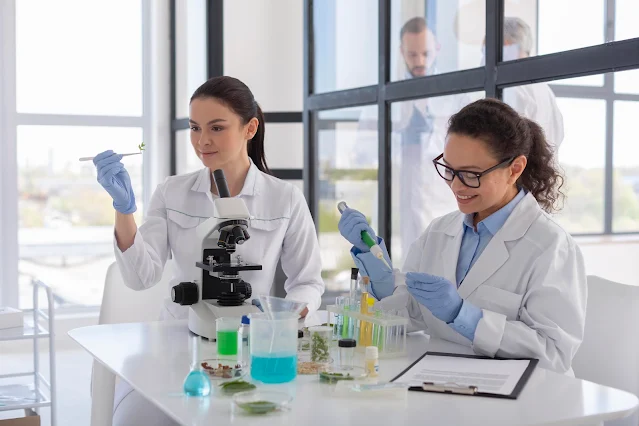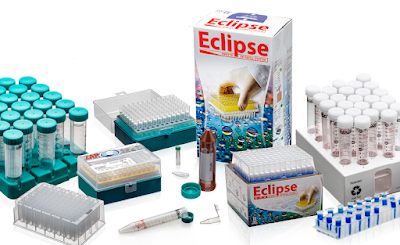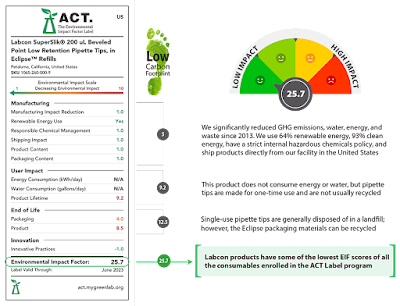Embracing A Sustainable Laboratory: The Importance of Adopting Eco-Friendly Consumables That You Need to Know
In our quest for sustainable scientific practices, one of the most crucial yet often overlooked aspects is the choice of laboratory consumables. Believe it or not, labs worldwide generate over 5.5 million tons of plastic waste annually! That's like adding a whole new plastic mountain to our planet annually. Crazy, right?
A big chunk of this waste comes from all those convenient single-use plastic items you rely on in the lab daily like pipette tips, sample containers, centrifuge tubes, and many more. If left unaddressed, this waste will continue to worsen pollution, habitat degradation, and even threats to wildlife. Plus, producing and disposing of these consumables involves energy-intensive processes which add to greenhouse gas emissions and exacerbate climate change. While laboratories are at the forefront of scientific advancement, how we use the resources and choices we make can profoundly impact our shared ecology.
What are Eco-Friendly Laboratory Consumables?
Eco-friendly laboratory consumables are products used in laboratories that are designed to minimize their environmental impact. Instead of conventional petroleum-based plastics, they are typically made from sustainable materials like carbon-sequestering bioplastics, recycled plastics, glass, or paper. Some are even biodegradable. Additionally, their production processes aim to reduce water, energy & waste, and minimize the release of harmful substances by utilizing energy-efficient manufacturing techniques or renewable resources. The consumables themselves often come with recyclable packaging or use minimal plastic content. So, are you ready to make a simple switch that makes a big difference for the planet?
Benefits of Utilizing Eco-Friendly Laboratory Equipment
Your lab holds unlimited potential for implementing small changes that can enhance its environmental footprint. Embracing eco-friendly labware supplies is not just a trend—it's your choice to be a part of the green revolution and contribute positively to our planet. Let's explore the incredible benefits of going green in the lab!
Impact on Environmental & Society
Labware supplies of this nature are crafted with sustainability at the forefront. Utilizing materials such as reusable, recyclable, biodegradable, or non-toxic substances plays a crucial role in waste reduction, conservation of natural resources, and ultimately, in combating global climate change. Suppliers that prioritize sustainability recognize the significant impact the manufacturing process, distribution, and product lifecycle management can have on laboratory operations.
Energy Efficiency
Eco-friendly alternatives often incorporate energy-efficient designs and technologies. This aspect is crucial in reducing the carbon footprint associated with laboratory operations. Energy-efficient equipment consumes less energy during operation, leading to lower greenhouse gas emissions. Additionally, utilizing renewable energy sources such as solar or wind power in the manufacturing processes results in immediate and measurable benefits. Every electron is accounted for!
Health & Safety
Managing lab tasks can be demanding, while ensuring personnel safety should never be an afterthought. Opting for eco-friendly lab products, which typically contain fewer harmful chemicals and toxins, fosters a safer working environment for lab personnel which helps minimize the risk of exposure to hazardous substances. Products may be Disposable, People are Not.
Save Costs in Long Run
While eco-friendly labware supplies may have a higher initial cost, it often built with durability in mind which is commonly using high-quality materials such as 100% polypropylene. It offers long-term savings through a longer lifespan, reduced energy consumption, and lower maintenance requirements. Product defects are also significantly lower compared to cheaper alternatives. Even though you might feel a pinch in your wallet initially, you will get more value than you expected!
Corporate Social Responsibility
Companies that embrace sustainability goals will not only benefit society but can bring their businesses a competitive advantage. Furthermore, it can enhance a company's reputation and appeal to environmentally conscious consumers and stakeholders.
Why are Eco-Friendly Laboratory Products Expensive?
Why do these eco-friendly lab supplies have to cost so much? Shouldn't they be cheaper since they're better for the environment? Well, this is the most common question that we get when talking about sustainable lab supplies. Their higher costs are often justified by their environmental benefits, ethical considerations, and long-term sustainability. Allow us to simplify this for you in a manner that will be comprehensible.
Raw Material Costs
First off, let's talk about raw materials. Environmentally friendly materials, such as sustainably sourced materials, can be more expensive to acquire than their conventional counterparts. Their production might require specialized cultivation, extraction, or processing methods, which can drive up costs due to scarcity and increased effort in sourcing.
Research and Development (R&D) Expenses
Creating sustainable lab equipment isn't just a matter of flipping a switch. It takes extensive research, experimentation, and innovation to come up with solutions that are both eco-friendly and effective. Companies invest significant resources into R&D to refine sustainable materials and methods.
Stringent Quality Standards and Certifications to Eliminate Green-washing
Eco-friendly products have to jump through hoops to meet strict environmental and sustainability certifications. This means investing in testing, audits, and compliance procedures to ensure that the products meet the required standards. For instance, applying ACT-labeled takes 2 to 6 months and involves scrutinizing every aspect of the product's manufacturing process and the manufacturer's environmental initiatives. Such meticulous scrutiny ensures transparency and credibility but adds to the overall cost of the product.
How to Identify Eco-Friendly Lab Products?
You might be curious about how you can identify an eco-friendly labware supply. Firstly, you should look for those products that have been evaluated and registered under the ACT Environmental Impact Factor Label program. It was developed by the non-profit organization My Green Lab, to evaluate the environmental impact of various laboratory products. The ACT label is like an eco-nutrition label for lab products which emphasizes three key principles: Accountability, Consistency, and Transparency.
The product labels are not found on the product but are published in an online database. To verify if your lab consumables are ACT registered, visit their website here.
Conclusion
Embracing eco-friendly lab consumables goes beyond environmental consciousness—it's about ensuring safer and healthier laboratory operations. By adopting a more eco-conscious approach, you can make a significant positive impact on the environment and society.
Labcon leads the industry with the largest selection of sustainable lab products globally, boasting over 600 ACT-certified items and holding the lowest Environmental Impact Factor (EIF) score worldwide. Choosing Labcon means prioritizing sustainability and safety in your lab.
If you are looking for an authorized Labcon distributor in Malaysia, look no further than Matrioux. Our dedicated team of highly trained product specialists and industry experts is always ready to assist you at every step.


.png)


.png)
